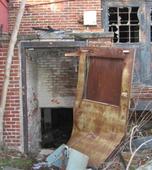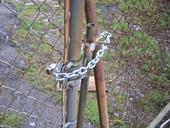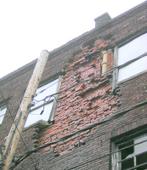This afternoon I had the opportunity to visit 669 Genesee Street once more. I've written about it before:
While the block of buildings that Willert Genrich owns and wants to demolish on Genesee Street near Chippewa, the so called "Genesee Village," has received more attention from community minded activists and preservationists during the last 6 weeks than this three building 1920's light industrial business campus has, I am left wondering again why this might be the case. While certainly unique and totally cool, the so called Genesee Village is not part of any historic district nor do the buildings have any protective "land-mark" status.
One is left wondering why the city has failed to site Willert Genrich for any building code violations at 109 Genesee Street. I'm sure the inspection folder for that property has either been misplaced or gathered so much dust by now that all the city inspectors thought it was some sort of done deal. Ask yourself, are new laws really going to prevent "demolition by neglect." Why not simply enforce current building codes?
Please take a moment to familiarize yourself with the my two previous posts to get up-to-date about 669 Genesee Street which is only one mile away from the "Genesee Village" (Cool google map.)
This afternoon with another urbex-tourist in tow we set out to see if the 669 campus was secure. We quickly found that the Division of Real Estate secured first floor access points and placed a lock and chain on the front fence, the rear gate well...itwas still wide open. So, we walked in to make certain that the building's rear entry points were secure. We also wanted to know if the water was finally turned off after 5 years of gushing all over the basement floor.
On March 17th this door was wide open and is now secured.
Here's the new front gate security system and another rear entry door secured.
One is left wondering why the city has failed to site Willert Genrich for any building code violations at 109 Genesee Street. I'm sure the inspection folder for that property has either been misplaced or gathered so much dust by now that all the city inspectors thought it was some sort of done deal. Ask yourself, are new laws really going to prevent "demolition by neglect." Why not simply enforce current building codes?
Please take a moment to familiarize yourself with the my two previous posts to get up-to-date about 669 Genesee Street which is only one mile away from the "Genesee Village" (Cool google map.)
This afternoon with another urbex-tourist in tow we set out to see if the 669 campus was secure. We quickly found that the Division of Real Estate secured first floor access points and placed a lock and chain on the front fence, the rear gate well...itwas still wide open. So, we walked in to make certain that the building's rear entry points were secure. We also wanted to know if the water was finally turned off after 5 years of gushing all over the basement floor.
On March 17th this door was wide open and is now secured.
Here's the new front gate security system and another rear entry door secured.
So, lacking any access to the basement to check on the water situation we went to the front and located the water shut-off hole in the sidewalk. We noticed that some fresh blue paint had been sprayed in the area and that the hole was full of lots of debris which looked as though it had been there for years.
Heading around towards the front of the building we noticed this on the Monroe Street side.

click to enlarge
All these bricks are falling from this crumbling spot on the third floor which can be seen from these pictures. Text book case of "demolition by neglect."
I've contacted a few attorneys this evening and hope to put the city on formal legal notice early this week regarding the crumbling third floor and the brick liability thing. I fully understand that the city is self insured for these sorts of liability risks and perhaps a little legal nudge will remind them that these sorts of liability exposures are certainly not acceptable in privately owned buildings yet seem to be ok when the city owns it.
Of course there are three additional examples of municipally owned "historic structures" that are crumbling or as Sam Hoyt likes to say about privately owned buildings in the same condition, "demolition by neglect." These other historic buildings that are crumbling on the city's watch include:
Perhaps Assemblyman Sam Hoyt's new "let's stop demolition by neglect" legislation is inspired by this example. Recent e-mail correspondence with him, suggests otherwise...and so it goes.
If anyone would like to sign on and be part of the "notice of definiency" I intend to file this week against the City of Buffalo, please contact me thru my e-mail, davidtorke at gmail dot com.
Of course there are three additional examples of municipally owned "historic structures" that are crumbling or as Sam Hoyt likes to say about privately owned buildings in the same condition, "demolition by neglect." These other historic buildings that are crumbling on the city's watch include:
Perhaps Assemblyman Sam Hoyt's new "let's stop demolition by neglect" legislation is inspired by this example. Recent e-mail correspondence with him, suggests otherwise...and so it goes.
If anyone would like to sign on and be part of the "notice of definiency" I intend to file this week against the City of Buffalo, please contact me thru my e-mail, davidtorke at gmail dot com.
__________________________________________________________________________
Artspace Archive • Annals of Neglect • BAVPA • Where is Perrysburg? • Broken Promises...
Writing the City • Woodlawn Row Houses • Tour dé Neglect - 2006 • faq
Artspace Archive • Annals of Neglect • BAVPA • Where is Perrysburg? • Broken Promises...
Writing the City • Woodlawn Row Houses • Tour dé Neglect - 2006 • faq







No comments:
Post a Comment